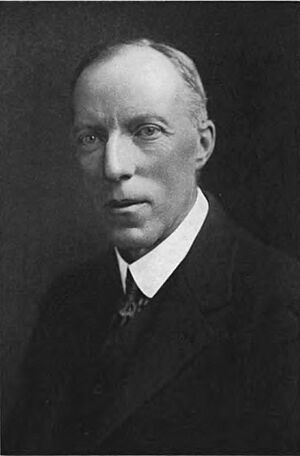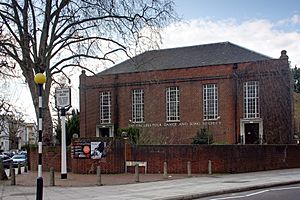English Folk Dance and Song Society facts for kids
| Abbreviation | EFDSS |
|---|---|
| Formation | 1932 |
| Type | Nonprofit organisation |
| Purpose | Research, study and promotion of English folk music and folk dance |
| Headquarters | London, United Kingdom |
|
Region served
|
England |
|
Chief Executive and Artistic Director
|
Katy Spicer |
|
Budget
|
£1.5 million |
| Website | www.efdss.org |
The English Folk Dance and Song Society (EFDSS, pronounced 'EFF-diss') is a group that helps keep English folk music and folk dance alive. It started in 1932 when two older groups, the Folk-Song Society and the English Folk Dance Society, joined together. The EFDSS is a charity that people can join, and it officially became a charity in 1963.
Contents
How the EFDSS Started

The EFDSS was created by combining two important groups. The first was the Folk-Song Society, which began in London in 1898. This group focused on finding and sharing traditional folk songs, mostly from Britain and Ireland. Many famous people were part of this society, including Lucy Broadwood and Ralph Vaughan Williams.
The second group was the English Folk Dance Society, started in 1911 by Cecil Sharp. Its goal was to protect and promote traditional English folk dances. This included dances like Morris dancing, sword dances, and other old social dances. Lady Mary Hepburn-Stuart-Forbes-Trefusis was the first secretary of this society. A hall at the EFDSS headquarters is named after her.
One of the biggest things the EFDSS has done for folk music and dance is to create folk festivals. These started in the 1940s in places like Stratford-upon-Avon. Today, many popular festivals continue in towns like Whitby and Sidmouth.
Cecil Sharp House: The EFDSS Home
The EFDSS is based at a special building called Cecil Sharp House. It is located in Camden, North London. This building was designed specifically for the English Folk Dance Society and opened in 1930. It has a unique style called neo-Georgian.
The most impressive part of the building is Kennedy Hall. This is a large space used for concerts and performances. It has a special floor that is great for dancing. The hall was designed to have excellent sound quality.
During the Second World War, in 1940, the building was damaged by bombs. The main hall, entrance, and stairs were hit. After the war, the building was repaired and reopened in 1951. A large painting by Ivon Hitchens was added to the main hall in 1954. This painting shows different English folk dances and traditions. It was the biggest single-wall painting in the United Kingdom when it was unveiled.
Besides Kennedy Hall, Cecil Sharp House has smaller rooms for practice and performances. There is also a café and bar. The building is also home to the Vaughan Williams Memorial Library and Archive. This library is a huge collection of folk music, dance, and song materials. Cecil Sharp House is a busy place for concerts, meetings, and other events. In 2015, it was even voted one of London's best music venues.
What the EFDSS Does Now
Since 1998, the EFDSS has focused on teaching and collecting. Their main goal is to make the Vaughan Williams Memorial Library the best place in the country for folk music, dance, and song information.
In 2009, the EFDSS became a group that regularly receives funding from Arts Council England. This helps them continue their important work.
In 2011, the EFDSS worked with Shrewsbury Folk Festival on a project called the Cecil Sharp Project. This project brought together many artists to create new music inspired by Cecil Sharp's life and his collection of folk songs. Famous artists like Steve Knightley and Jim Moray were part of this project.
In 2013, the EFDSS launched The Full English. This is a huge online collection of traditional music and dance tunes. It has over 44,000 records and 58,000 digital images. It is the largest digital archive of its kind in the world and is free to use.
The EFDSS also hosts many different performers at Cecil Sharp House. Groups like the Ukulele Orchestra of Great Britain and the Swingle Singers have performed there.
In September 2021, the EFDSS started thinking about changing its name. Some people felt the name did not fully show what the society does today. They considered names like 'Folk Arts England'. In November 2021, most members liked this new name. However, as of August 2025, the organization is still known as the English Folk Dance and Song Society.
EFDSS Gold Badge Awards
The EFDSS Gold Badge Award started in 1922. It is given to people who have done amazing things for folk music, dance, or the wider folk community. Many people who have received this award are well-known figures in British culture.
Some of the notable people who have received this award include:
- 1923: Cecil Sharp
- 1943: Dr Ralph Vaughan Williams
- 1975: A L Lloyd
- 1982: The Watersons (a famous folk music family)
- 1987: Peggy Seeger
- 2002: John Kirkpatrick and Dave Swarbrick
- 2007: Eliza Carthy
- 2014: Maddy Prior and Sandra Kerr
- 2019: Kate Rusby
See also
- Vaughan Williams Memorial Library
- Country Dance and Song Society, a similar group in America


